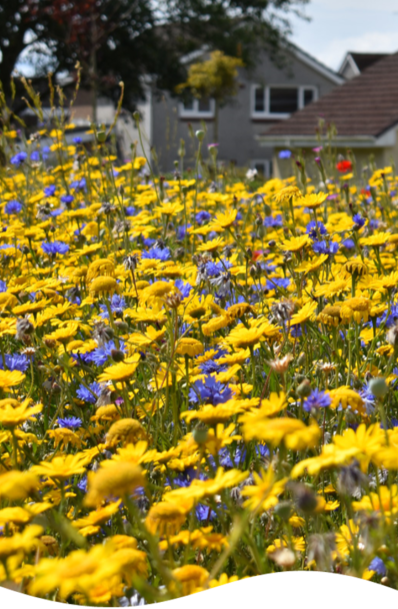Helping Pollinators leaflet

Published: 2023

Create nesting sites and shelter
Pollinators need different things at different stages of their life-cycles, and different types of pollinators will have their own particular needs. There are a number of things you can do to improve pollinators’ nesting options, for example:
- leave some bare south-facing earth for mining bees;
- allow some areas to grow wild to offer long grass for shelter and nesting sites – along the bottom of fence lines or hedgerows is a good spot;
- rather than a bee house why not simply drill some holes into wooden posts for solitary bees?
- dry stone walls, pile of logs and hedgerows can also offer nesting sites for a range of species.
Take care with bee houses
There has been considerable interest in bee houses in recent years. However, these ‘hotels’ do come with some risks. It is often overlooked that they do need to be cleaned – if they aren’t they could pose a risk to pollinators by encouraging the spread of pests or disease. Don’t build large bee houses, these aren’t easy to maintain. If you do decide to have a bee hotel remember that you need to maintain it, and nothing larger than the average bird box is necessary.
Find out more on our web page.

Plant for pollinators
Spring and autumn are tricky months for pollinators as they emerge from or prepare to enter hibernation and they need flowers that produce lots of nectar (for energy) and pollen (for protein). The key period for your garden to be in bloom for pollinators is between March and October.
Our Planting for Pollinators leaflet has more information.
Get involved in monitoring
Take part in citizen science monitoring and recording schemes. The UK Pollinator Monitoring Scheme 10 minute Flower-Insect-Timed Counts (FIT Counts) are a great way to get started. You can take part in warm, dry weather any time between April and September and submit your result using their simple App.
Bumblebee Conservation Trust’s BeeWalk is a bumblebee monitoring scheme for volunteers which simply requires walking a fixed route once a month between March and October, counting the bumblebees you see, and submitting your results. It’s an enjoyable and very useful survey to get involved in.
Pesticides and herbicides
Aim wherever possible to manage your greenspace without the use of pesticides or herbicides. Herbicides should only be used in extreme cases and with great caution, such as on invasive non-native species. They must be used carefully as they have the capacity to remove neighbouring pollinator-friendly weeds and therefore a valuable food source. Insecticides have a number of harmful impacts on insects.

Mow less
Many of us have been brought up to believe that a tidy garden and a well-clipped lawn are part and parcel of efficient gardening. However, consider reducing mowing to create an undisturbed wildflower patch or strip for pollinators. You can do this, for example, in gardens, allotments, school grounds, local parks and around farms. Larger areas can be left alone but have paths mown through or around them to allow you access to enjoy the wildlife using it.
Spare some weeds
So-called weeds have had a bad press but they’re still wild flowers, just growing where we don’t want them to be! A good example is the much maligned dandelion. Dandelions provide a crucial source of food for early emerging pollinators such as queen bumblebees. Try to avoid pulling them out, using herbicides on them or cutting your grass as far as possible and they will provide a fantastic and important source of food for all types of pollinators.
Hedges
A flowering hedgerow can be just what pollinators need. Allow them to flower in spring before pruning. Species such as hawthorn and blackthorn are an excellent food resource for pollinators in spring. Hedgerows not only provide food but are also convenient and natural corridors for wildlife to move through the landscape, and offer shelter and nesting sites for insects, birds and smaller mammals.
Pollinator friendly trees
The likes of willow, holly, apple, wild cherry, hazel and rowan, to name but a few are an important asset for pollinators. Whether providing spring blossom or late season flowers a variety of native trees and shrubs have the potential to offer a vital life-line for hungry pollinators.
Helping our pollinators
Scotland’s pollinators are a vital part of our biodiversity. Species such as bees and hoverflies are a familiar sight in our gardens, parks and countryside. They play a crucial role in our food and farming industries, as well as contributing to our enjoyment of the outdoors and our health and wellbeing.
But our wild pollinators are under threat. Faced with pressures that include habitat fragmentation, changes in land use, disease, pesticides and climate change they need our help.
The Pollinator Strategy for Scotland is the work of many partners. Delivering a wide range of activities, it draws together the expertise and enthusiasm of a wide range of organisations, government agencies and businesses.
We have lots of information on how to help pollinators on our website.
Follow us on twitter at ScotPollinators.
And read our regular blogs at Scottishpollinators.







